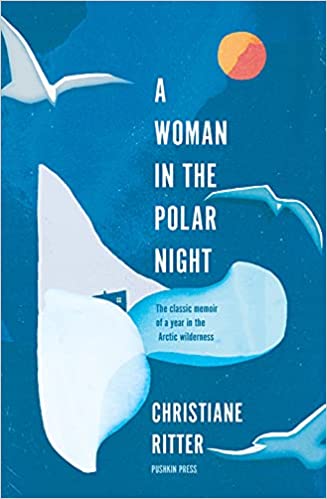“An absolute banger of a book!” – Katie
What more can I add to Katie’s review? Well let’s start with a synopsis of the book. In 1934 Christiane Ritter, an Austrian artist, joins her husband, an explorer and hunter, in the Arctic to live for a year on the remote island of Spitsbergen. This book is her memoir of the time, complete with all that comes of living in the Arctic circle- snow, freezing cold, ice, bears, seals and more snow. Considered a feminism classic, the book tells the story of a woman remarkable in her time and ours. She meets her husband and treks to the remote cabin they’ll share with Karl, another hunter.

The book takes us through the winter when there’s no daylight for months and Christiane spends weeks on end alone in the cabin waiting for her husband to return from hunting trips. We read of the amazing nature surrounding her, the solitude, the connection to the landscape and animals, the polar lights, and eventually her return home to her child and normal life, leaving her husband behind. Christiane Ritter passed away in 2000 at the age of 103, and some of her art work can be seen at: https://digitaltmuseum.no/search/?q=christiane+ritter&aq=owner%3F%3A%22SVB%22
Our reading group loved this book, everyone found something to say about it, and took something different from the writing. We talked about having to accept that it was written in the 1930s, and that she was expected to perform much of the “housework” in the cabin, although the men certainly joined in when they were there. We struggled a little with the details of animals being killed for food and for fur, and related to Christiane’s distaste of the hunting. She recognised that it was necessary for their survival, and was at times all consumed by the idea of getting enough nourishment and vitamins to survive. It was a very busy book, she was constantly cooking or cleaning or sewing, there was always something to do.
We talked about reading this book in the current climate in which we live, and several of us wanted to run away and experience the simpler life in the book. Most of us were put off by the extreme cold though, we all felt it when reading! The discussion took in the way that the author became attuned to nature, and appreciated where she was living, despite its desolate nature. The link to nature and the animals there resonated with many of us. We particularly liked Mikkl the arctic fox.

Some of us were fascinated by the practicalities of how they lived, and we thought that was a sign of when it was written. Today we’d have known the location of the toilet and would probably have seen a video or vlog of what life was like. Instead, at the start of the reading group meeting we looked at modern day photos of the cabin and were struck by its diminutive size and basic nature. See more at: https://www.siefkes.de/dokumente/Siefkes_Darkness_presentation.pdf It felt claustrophobic, particularly when she described the huge snow drifts that covered the hut except for its chimney, and the need to clear several feet of snow from the door each day to get outside. The little drawings in the book and the photos at the end were really helpful in imagining the place and putting it into context. Finding a little snippet of a drawing on a page was an added bonus and really added to the book.
The area that we found disappointing in the book was her relationship with her husband, which, considering she’d travelled to live with him, didn’t seem to have any romance. We wondered when he’d returned home, and how they could both have left their small child behind for so long. The general consensus was that he was rather selfish, but we did allow that his behaviour was probably more normal in the time then the book was written. It was interesting that when Christiane’s mental health deteriorated in the darkness of the winter with no daylight, it was mentioned only briefly with little narrative around it. We thought that would have been written quite differently today, or if the book had been a fictional tale rather than a memoir.
All told we would definitely recommend this book. It isn’t something many of us would have picked up given the choice, but we’re glad we read it. That’s the beauty of a reading group- we push people to try something new, and in this book it paid off!

Our next read is The Good People by Hannah Kent. As ever copies will be available to pick up in the library, ready for our next meeting in June.
Find out more about our reading groups here
Take a look at the blog posts for our previous reads here.
